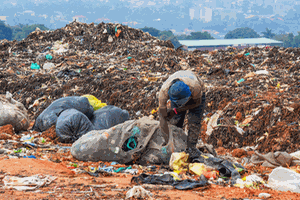How model homes are tackling malnutrition in rural communities

Mr Josesph Bemba, the deputy country director Sasakawa Africa Association addresses mothers who turned up for the training. Photo/Jane Nafula.
What you need to know:
- According to the World Health Organisation (WHO), malnutrition refers to deficiencies or excesses in nutrient intake, imbalance of essential nutrients or impaired nutrient utilization.
It is 10am, 28-year-old Grace Nakato Nakibuuka, a mother of five from Kitanzige Village in Lwamata Sub County, Kiboga District joins several other youthful mothers, gathered at a model home belonging to Ms Jane Nabukenya, a 63-year-old farmer from Kyekumbya Village in Kyekumbya Parish.
The model home has a well-kept compound and is sandwiched between plantations of bananas, cassava, sweet potatoes, fruit trees and vegetable gardens.
While carrying her 9-month-old son, who looks too short and small for his age, and has curly brownish hair, Nakato settles on a seat in a well-constructed shade, within the compound of a model home, as she awaits nutrition lessons organized by Sasakawa Africa Association.
According to Nakato, she always feeds her son on porridge made out of cassava flour, saying she can’t afford milk sold by local vendors at Shs 500 per cup.
Besides, a friend allegedly assured her that both milk and cassava porridge contain the same food values since they are both whitish in colour.
After over 30 mothers and their babies whose physical appearance is a testament of nutrient deficiencies, have gathered at the shade, the training team led by Sasakawa staff takes them through different types of food and nutrients each of them contains, healthy food choices and how to feed children and other family members on a balanced diet, using locally available foods.
Mr Josesph Bemba, the Deputy Country Director, Sasakawa Africa Association said the organisation was piloting model homes in selected districts to act as a centre where, women of child-bearing age, mothers, the elderly, and people living with HIV/AIDS, gather and learner about proper feeding, sanitation and proper hygiene.
“This is one of the one-stop centre nutrition model home that we are supporting. It has a training centre where we train everybody, to get information about nutrition. We also invite women of child-bearing age and those with malnourished cases, to come and receive training on how they should feed children and support the home to locally make composites that families can come and access at a small fee,”Mr Bemba said while pointing said.
The model homes are currently being piloted in the Districts of Mubende, Kiboga, Rakai, Isingiro, Otuke, Kole and Napak.
Mr Bemba explained that the decision to come up with such homes was triggered by the severe cases of malnutrition that they came across, as they implemented other project activities.
“So many children were stunted, parents did not know how to feed them. Feeding babies on food with the right nutrients especially between zero and six years is important because these are very critical years in boosting the child’s immunity, brain development,” he said.
Both Uganda’s Ministry of Health and the World Health Organization (WHO) recommend that infants should be fed on breast milk within one hour of birth, be exclusively breastfed for the first six months, and continue breastfeeding until 2 years of age or beyond.
The duo state that at the age of 6 months, babies should be introduced to soft foods comprised of a variety of food groups and should continue to be breast fed.
Gender issues
Mr Bemba however, noted that to achieve proper nutrition, both men and women should be helped to understand what it takes to have a balanced diet.
“Communities don't know how to use the different foods to achieve nutritional needs. Once a man establishes a banana plantation, he thinks that is what food is all about, "he says.
Bemba added, “Malnutrition has a gender perspective. Both men and women need to understand what nutrition is about, so that even when they are planning for the resources in their homes, they invest some money in foods that are not grown by the family.’’

He also notes that nutrition is a national issue that both the rich and poor need to understand to make healthy choices.
He says that while the poor are malnourished because they lack enough food, the rich who have food in plenty, overeat it, are grappling with obesity.
He says the organisation is currently implementing a five-year Strategic Plan, promoting nutrition sensitive agriculture, regenerative agriculture and market-oriented agriculture.
The nutrition sensitive agriculture support communities, not only to produce and sell food, but also to have balanced meals in their communities.
Mr Festo Nsokwa, health assistant in charge of Lwamata Parish in Kyekumbya Sub County, Kiboga District said the most critical time for good nutrition is during the 1,000-day period from pregnancy until a child’s second birthday.
Mr Nsokwa said few families adhere to proper nutrition since most of them sell off almost everything that they produce at home.
“When the have cows, they sell at the milk, the poultry farmers sell all eggs and chicken. The same applies to food crops. People love money more that their own lives,” he observed.
Ms Jacqueline Namusalisi, Technical Coordinator, Nutrition Sensitive Agriculture at Sasakawa Africa Association said malnutrition cases are high among children born to child mothers.
“Some of these young mothers have been abandoned by the men who made them pregnant. They are struggling on their own to take care of themselves and their babies,” Ms Namusalisi said.
Young women who get pregnant tend to give birth to low birth-weight babies, which predisposes children to malnutrition.
Ms Jane Nalunga, Councilor, representing Persons with Disabilities (PWDs) in Kyekumbya Parish said malnutrition is worse among mothers with disabilities who are not able to engage in productive activities because of the nature of their disability.
According to Unicef, more than one third of young children (2.4 million) are stunted.
Half of children under five and one quarter of child-bearing-age women are anemic.
Uganda is among the 20 countries worldwide with the highest burden of malnutrition and threatens to destroy a generation of children with more than one third of all young children.
Background
According to the World Health Organisation (WHO), malnutrition refers to deficiencies or excesses in nutrient intake, imbalance of essential nutrients or impaired nutrient utilization.
The double burden of malnutrition consists of both undernutrition and overweight and obesity, as well as diet-related no communicable diseases.
Undernutrition manifests in form of wasting, stunting, underweight, and micronutrient deficiencies.
Wasting is defined as low weight-for-height. It often indicates recent and severe weight loss, although it can also persist for a long time. It usually occurs when a person has not had food of adequate quality and quantity and/or they have had frequent or prolonged illnesses.
Stunting is defined as low height-for-age. It is the result of chronic or recurrent undernutrition, usually associated with poverty, poor maternal health and nutrition, frequent illness and/or inappropriate feeding and care in early life. Stunting prevents children from reaching their physical and cognitive potential.
Underweight is where a child had low weight-for-age. A child who is underweight may be stunted, wasted or both.
Micronutrient deficiencies are a lack of vitamins and minerals that are essential for body functions such as producing enzymes, hormones and other substances needed for growth and development.




